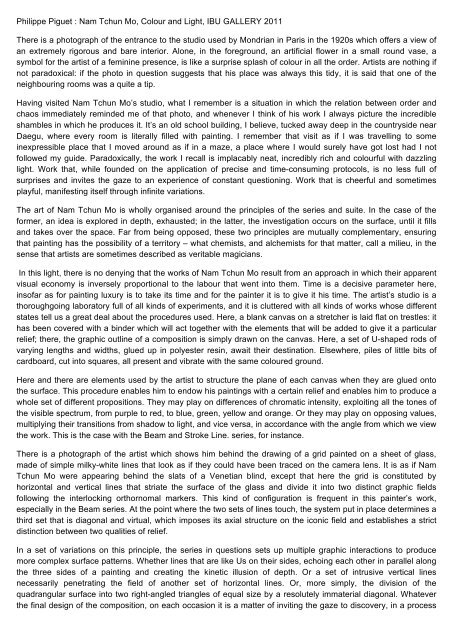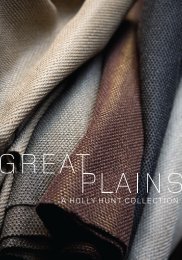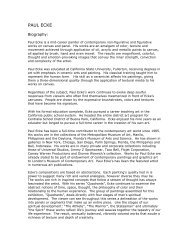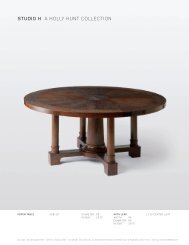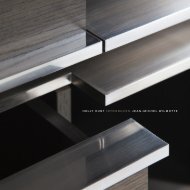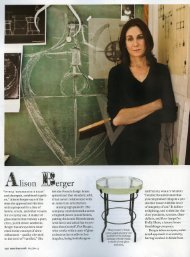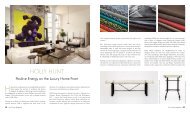Philippe Piguet on Nam Tchun Mo - Holly Hunt
Philippe Piguet on Nam Tchun Mo - Holly Hunt
Philippe Piguet on Nam Tchun Mo - Holly Hunt
Create successful ePaper yourself
Turn your PDF publications into a flip-book with our unique Google optimized e-Paper software.
<str<strong>on</strong>g>Philippe</str<strong>on</strong>g> <str<strong>on</strong>g>Piguet</str<strong>on</strong>g> : <strong>Nam</strong> <strong>Tchun</strong> <strong>Mo</strong>, Colour and Light, IBU GALLERY 2011<br />
There is a photograph of the entrance to the studio used by M<strong>on</strong>drian in Paris in the 1920s which offers a view of<br />
an extremely rigorous and bare interior. Al<strong>on</strong>e, in the foreground, an artificial flower in a small round vase, a<br />
symbol for the artist of a feminine presence, is like a surprise splash of colour in all the order. Artists are nothing if<br />
not paradoxical: if the photo in questi<strong>on</strong> suggests that his place was always this tidy, it is said that <strong>on</strong>e of the<br />
neighbouring rooms was a quite a tip.<br />
Having visited <strong>Nam</strong> <strong>Tchun</strong> <strong>Mo</strong>’s studio, what I remember is a situati<strong>on</strong> in which the relati<strong>on</strong> between order and<br />
chaos immediately reminded me of that photo, and whenever I think of his work I always picture the incredible<br />
shambles in which he produces it. It’s an old school building, I believe, tucked away deep in the countryside near<br />
Daegu, where every room is literally filled with painting. I remember that visit as if I was travelling to some<br />
inexpressible place that I moved around as if in a maze, a place where I would surely have got lost had I not<br />
followed my guide. Paradoxically, the work I recall is implacably neat, incredibly rich and colourful with dazzling<br />
light. Work that, while founded <strong>on</strong> the applicati<strong>on</strong> of precise and time-c<strong>on</strong>suming protocols, is no less full of<br />
surprises and invites the gaze to an experience of c<strong>on</strong>stant questi<strong>on</strong>ing. Work that is cheerful and sometimes<br />
playful, manifesting itself through infinite variati<strong>on</strong>s.<br />
The art of <strong>Nam</strong> <strong>Tchun</strong> <strong>Mo</strong> is wholly organised around the principles of the series and suite. In the case of the<br />
former, an idea is explored in depth, exhausted; in the latter, the investigati<strong>on</strong> occurs <strong>on</strong> the surface, until it fills<br />
and takes over the space. Far from being opposed, these two principles are mutually complementary, ensuring<br />
that painting has the possibility of a territory – what chemists, and alchemists for that matter, call a milieu, in the<br />
sense that artists are sometimes described as veritable magicians.<br />
In this light, there is no denying that the works of <strong>Nam</strong> <strong>Tchun</strong> <strong>Mo</strong> result from an approach in which their apparent<br />
visual ec<strong>on</strong>omy is inversely proporti<strong>on</strong>al to the labour that went into them. Time is a decisive parameter here,<br />
insofar as for painting luxury is to take its time and for the painter it is to give it his time. The artist’s studio is a<br />
thoroughgoing laboratory full of all kinds of experiments, and it is cluttered with all kinds of works whose different<br />
states tell us a great deal about the procedures used. Here, a blank canvas <strong>on</strong> a stretcher is laid flat <strong>on</strong> trestles: it<br />
has been covered with a binder which will act together with the elements that will be added to give it a particular<br />
relief; there, the graphic outline of a compositi<strong>on</strong> is simply drawn <strong>on</strong> the canvas. Here, a set of U-shaped rods of<br />
varying lengths and widths, glued up in polyester resin, await their destinati<strong>on</strong>. Elsewhere, piles of little bits of<br />
cardboard, cut into squares, all present and vibrate with the same coloured ground.<br />
Here and there are elements used by the artist to structure the plane of each canvas when they are glued <strong>on</strong>to<br />
the surface. This procedure enables him to endow his paintings with a certain relief and enables him to produce a<br />
whole set of different propositi<strong>on</strong>s. They may play <strong>on</strong> differences of chromatic intensity, exploiting all the t<strong>on</strong>es of<br />
the visible spectrum, from purple to red, to blue, green, yellow and orange. Or they may play <strong>on</strong> opposing values,<br />
multiplying their transiti<strong>on</strong>s from shadow to light, and vice versa, in accordance with the angle from which we view<br />
the work. This is the case with the Beam and Stroke Line. series, for instance.<br />
There is a photograph of the artist which shows him behind the drawing of a grid painted <strong>on</strong> a sheet of glass,<br />
made of simple milky-white lines that look as if they could have been traced <strong>on</strong> the camera lens. It is as if <strong>Nam</strong><br />
<strong>Tchun</strong> <strong>Mo</strong> were appearing behind the slats of a Venetian blind, except that here the grid is c<strong>on</strong>stituted by<br />
horiz<strong>on</strong>tal and vertical lines that striate the surface of the glass and divide it into two distinct graphic fields<br />
following the interlocking orthornomal markers. This kind of c<strong>on</strong>figurati<strong>on</strong> is frequent in this painter’s work,<br />
especially in the Beam series. At the point where the two sets of lines touch, the system put in place determines a<br />
third set that is diag<strong>on</strong>al and virtual, which imposes its axial structure <strong>on</strong> the ic<strong>on</strong>ic field and establishes a strict<br />
distincti<strong>on</strong> between two qualities of relief.<br />
In a set of variati<strong>on</strong>s <strong>on</strong> this principle, the series in questi<strong>on</strong>s sets up multiple graphic interacti<strong>on</strong>s to produce<br />
more complex surface patterns. Whether lines that are like Us <strong>on</strong> their sides, echoing each other in parallel al<strong>on</strong>g<br />
the three sides of a painting and creating the kinetic illusi<strong>on</strong> of depth. Or a set of intrusive vertical lines<br />
necessarily penetrating the field of another set of horiz<strong>on</strong>tal lines. Or, more simply, the divisi<strong>on</strong> of the<br />
quadrangular surface into two right-angled triangles of equal size by a resolutely immaterial diag<strong>on</strong>al. Whatever<br />
the final design of the compositi<strong>on</strong>, <strong>on</strong> each occasi<strong>on</strong> it is a matter of inviting the gaze to discovery, in a process
involving the effect of light in accordance with the positi<strong>on</strong> of the viewer and, in equal measure, the intensity of the<br />
colours brought into play.<br />
Colour and light are the key ingredients of <strong>Nam</strong> <strong>Tchun</strong> <strong>Mo</strong>’s art. He is c<strong>on</strong>stantly playing <strong>on</strong> them, exploiting the<br />
most varied resources of the chromatic spectrum – orange, yellow, purple, blue, vermili<strong>on</strong>, etc. – while not<br />
neglecting the subtle modulati<strong>on</strong>s of black and white. If he puts the emphasis <strong>on</strong> light colours, however, this is<br />
because, as Kandinsky points out in his book C<strong>on</strong>cerning the Spiritual in Art (1912), “they attract and hold the<br />
gaze more.” As we know, for the founder of abstract art, colour was “a power which directly influences the soul.”<br />
Looking bey<strong>on</strong>d formal intenti<strong>on</strong>s, the use of it by <strong>Nam</strong> <strong>Tchun</strong> <strong>Mo</strong> follows the same intenti<strong>on</strong>s and the viewer who<br />
comes across his work is immediately filled with a rare sensati<strong>on</strong>, that of a clear, luminous space that makes him<br />
vibrate in the depths of his being because of the ricochet that the acti<strong>on</strong> of colour has <strong>on</strong> his physical body.<br />
“Colour,” notes Kandinsky, “is the keyboard, the eyes are the hammers, the soul is the piano with many strings.<br />
The artist is the hand which plays, touching <strong>on</strong>e key or another, to cause vibrati<strong>on</strong>s in the soul.”<br />
With the works of an artist like <strong>Nam</strong> <strong>Tchun</strong> <strong>Mo</strong>, the risk is that we might c<strong>on</strong>sider <strong>on</strong>ly the formalist aspect of his<br />
approach, and gauge it solely in these terms. If this work is res<strong>on</strong>ant, it is because of <strong>Tchun</strong> <strong>Mo</strong> <strong>Nam</strong>’s decisi<strong>on</strong> to<br />
refuse everything that does not exclusively serve his painting. Familiar both with a c<strong>on</strong>crete form of art that is<br />
c<strong>on</strong>ducive to geometrical abstracti<strong>on</strong> and with a minimal art that seeks out inexpressive, simple forms linked<br />
serially together, <strong>Nam</strong> Tchum <strong>Mo</strong>’s painting paradoxically turns out to be the opposite of these. It has invented<br />
the means of a visual diversi<strong>on</strong>, like a composer of objective music who switches the apparently dogged rigour of<br />
his compositi<strong>on</strong>s into a c<strong>on</strong>stantly changing world.<br />
<strong>Nam</strong> <strong>Tchun</strong> <strong>Mo</strong>’s practice of the series is not based <strong>on</strong> some pre-established programme; it is the work itself that<br />
determines the series because it proceeds, fundamentally, from the very exercise of painting. Because there is a<br />
state of permanent revelati<strong>on</strong>s in painting. During the executi<strong>on</strong> of a painting the artist is c<strong>on</strong>stantly assailed by<br />
the c<strong>on</strong>trary, the complementary, the almost-identical and the slightly different with regard to what he is doing.<br />
Other paintings, other formulati<strong>on</strong>s appear to him, which he wants to start <strong>on</strong>. In the field of the visual arts, the<br />
objective is not to dem<strong>on</strong>strate know-how or its accumulati<strong>on</strong>, but to attain that moment of illuminati<strong>on</strong> that makes<br />
the work and that comes from a visi<strong>on</strong> w<strong>on</strong> in a quest bey<strong>on</strong>d appearance. In fact, it is about an even more subtle<br />
quest, the quest for something indefinable that has no real figurative form, and that can be brought to the fore in a<br />
series.<br />
To this end, light is the true keyst<strong>on</strong>e that determines the existence of the work and that governs the gaze<br />
brought to bear <strong>on</strong> it. <strong>Nam</strong> <strong>Tchun</strong> <strong>Mo</strong>’s painting is made <strong>on</strong>ly to offer him the chance of a test, if not an<br />
experiment—the ideal terrain for its radiance. “Painting is nothing but painting, it expresses <strong>on</strong>ly itself,” said<br />
Edouard Manet. <strong>Nam</strong> <strong>Tchun</strong> <strong>Mo</strong> aband<strong>on</strong>s it to its own dazzlement. He liberates its radiant power, to the point<br />
that we are almost blinded. From inside that famous cave, he invites us to look to the entrance, to witness the<br />
world’s superb brilliance.<br />
<str<strong>on</strong>g>Philippe</str<strong>on</strong>g> <str<strong>on</strong>g>Piguet</str<strong>on</strong>g>


